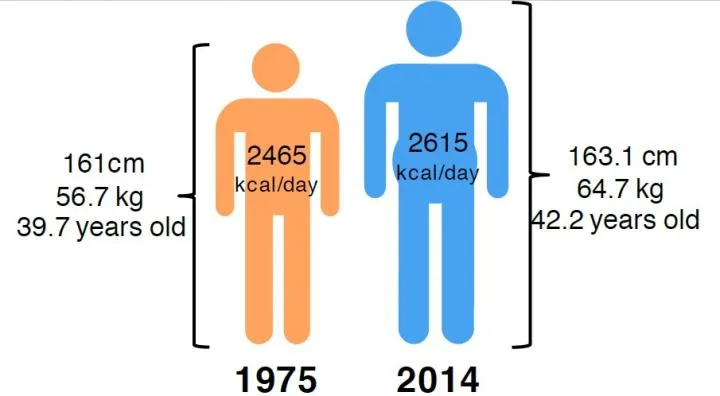Soon, the Average Human Will Be Taller, Heavier. That Will Lead to Increased Food Demand
Between 1975 and 2014, average adult grew 1.3 percent taller and 14 percent heavier, triggering 6.1 percent uptick in energy consumption
/https://tf-cmsv2-smithsonianmag-media.s3.amazonaws.com/filer/48/1e/481e2f20-2784-4a89-b39a-85e5db98fd30/good_food_display_-_nci_visuals_online.jpg)
By this time tomorrow, Earth’s population will include around 200,000 more people than it does right now. And at this high growth rate, it won’t take long for numbers to swell far beyond our current population of 7.6 billion: In fact, the United Nations projects the world will need to support a staggering 9.8 billion people by 2050, raising questions of how our overworked planet will be able to handle such a heavy strain on resources.
A new study published in Sustainability does little to assuage these concerns. As Chase Purdy reports for Quartz, researchers from the Norwegian University of Science and Technology drew on decades of demographic data from 186 countries to determine trends in humans’ height and weight. The team found that between 1975 and 2014, the average adult grew 1.3 percent taller and 14 percent heavier, triggering a 6.1 percent uptick in energy consumption. Thanks to this increase in body mass, average daily calorie counts rose from 2,465 in 1975 to 2,615 in 2014.
Essentially, study co-author Gibran Vita explains in a statement, the findings suggest feeding nine billion people today would represent an entirely different task than feeding that same number in 2050. Based on anticipated gains in weight and height, the average near-future human will be bigger than their 2018 counterpart and, as a result, will require more food.
There are a number of factors influencing this prediction, the researchers write in their report. Over the time period studied, demand for global food energy rose by 129 percent. Booming population growth accounted for 116 percent of this increase, while weight and height gains accounted for another 15 percent. Aging populations, which tend to require lower levels of energy, counteracted this growth by two percent, leaving the final figure at 129 percent rather than 131.
“Since the effect of biodemographic changes are cumulative, we can expect the observed inertia to extend into the future,” the authors note. “ … Based on the discovered trends, feeding nine billion people in 2050 will require significantly more total calories than feeding the same people today.”

David Jones of Market Business News writes that average weight gain ranged from six to 33 percent across the 186 countries surveyed. Increased energy requirement ranged from 0.9 to 16 percent. African countries exhibited the greatest gains in both categories, while Asian countries exhibited the lowest. An average individual from Tonga, for example, weighs 205 pounds and requires 800 more daily calories than the average Vietnamese resident, who weighs around 114 pounds.
According to the study, food requirements don’t always go hand in hand with weight and height gains. Although Japan saw increases in both weight and height between 1975 and 2014, the country maintained a similar level of food demand—a phenomenon explained by its rapidly aging population. Conversely, India’s residents exhibited increased energy needs based on medium weight gains and moderate aging. Environmental, lifestyle and genetic factors likely contributed to these discrepancies.
Scientists have already offered an array of solutions for meeting the daunting task of feeding nine billion, but as lead author Felipe Vásquez says in the statement, prior research has largely assumed that adults’ food needs remain consistent across time and countries.
"Previous studies haven't taken the increased demands of larger individuals and aged societies into account when calculating the future food needs of a growing population," Vásquez concludes. "These assumptions can lead to errors in assessing how much food we'll actually need to meet future demand."
/https://tf-cmsv2-smithsonianmag-media.s3.amazonaws.com/accounts/headshot/mellon.png)
/https://tf-cmsv2-smithsonianmag-media.s3.amazonaws.com/accounts/headshot/mellon.png)